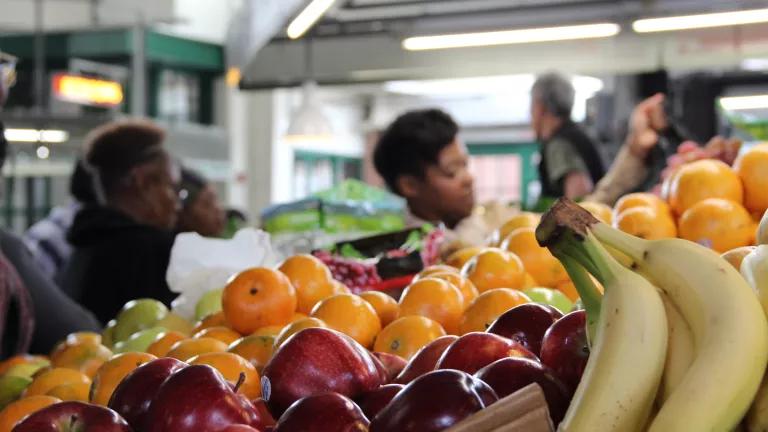Bill de Blasio's 3rd State-of-the-City speech tonight will be a perfect opportunity for the New York City Mayor to build upon the new environmental framework he unveiled in his ambitious OneNYC sustainability plan last April.
The Mayor's speech, like his previous major pronouncements, is likely to focus on inequality and the glaring economic disparities in the nation's largest city. But the beauty of de Blasio's approach to sustainability issues is that so many of New York City's longstanding environmental challenges fall squarely within the equity frame.
Here are five topics we'd like to see included in the Mayor's speech. Each one attacks an environmental problem and addresses inequities that have weighed on the City's less affluent residents over the years.
1) Scale up Energy Efficiency in Affordable Multifamily Housing
Increasing energy efficiency in affordable multifamily housing reduces the burdens on lower-income New Yorkers by cutting their energy costs and creating healthier, more comfortable conditions in their apartments. Reducing energy waste in these buildings is also essential to achieving Mayor de Blasio's ambitious greenhouse gas reduction goals. The Administration has taken important first steps on this issue by, for example, having the Department of Housing Preservation and Development and the Housing Development Corporation advance energy and water efficiency in buildings they finance. Now is the perfect time for the Mayor to announce the creation of a task force that will define specific strategies needed to achieve 80 per cent reductions in greenhouse gas emissions by 2050 (with intermediate benchmarks) in the city's affordable multifamily housing sector.
2) Build a Wholesale Farmers' Market in the South Bronx
Even though New York State is agriculturally rich and a top producer of fruits and vegetables, many city residents - especially those living in lower income neighborhoods - do not have sufficient opportunities to purchase fresh and healthy food. Building a wholesale farmers' market in the South Bronx might be the most important step that New York could take to spur the flow of locally grown, healthy food into bodegas, community centers and schools throughout the city. Such a facility should be located near the current Hunt's Point Produce Market, which primarily distributes food from giant farms outside the region (and outside the country) and which has not succeeded in getting sufficient fresh, regionally grown food into the city. The Mayor has supported building this new market in cooperation with the Cuomo Administration, and highlighting his commitment to it in the state-of-the-city address could be the spark that is needed to finally turn this concept into reality.
3) Revise the City's Regressive Water Rate Structure
Under an arcane city policy, New York's water rates include the cost of a "rental payment" for "leasing" the city's water and sewer system from itself. This rental payment amounts to a regressive tax on city water ratepayers. And it diverts a portion of water rate payments to non-water uses. The de Blasio Administration wisely moved to refund a portion of these rental payments to water ratepayers last year. If the Mayor were to announce a phase-out of these antiquated rental payments, hundreds of millions of dollars could be reallocated to water-related infrastructure investments that address such problems as sewer overflows and to programs that provide reductions in water bills to qualifying low-income senior and disabled customers.
4) Reform the Broken System of Commercial Waste Collection
The city's current system for collection of commercial trash involves multiple private carter trucks driving around the city and criss-crossing each other's routes. This system is inefficient, generates unnecessary traffic and air pollution and is not sufficiently protective of the rights or health of the private sanitation workers employed by the carting industry. In contrast, an exclusive zone system for commercial waste collection, like that recently adopted in Los Angeles, would enable the city to rationalize collection routes and set industry-wide standards for truck pollution, recycling and composting, worker safety, etc. It makes so much sense for the Mayor to get behind the labor/environmental justice coalition's legislative proposal to transform the city's broken system for disposing of commercial trash.
5) Incorporate Environmental Justice into Government Decision-Making
For decades, communities of color and other politically less powerful neighborhoods have borne more than their fair share of New York City's environmental burdens. To his credit, Mayor de Blasio made redressing such inequities a cornerstone of his sustainability plan, OneNYC, which was released in 2015. There is much that city government agencies can do within their own organizations and throughout the city to ameliorate environmental justice problems. New York City Councilmember Costa Constantinides recently chaired hearings on two bills that would prod city agencies to more systematically evaluate environmental justice threats and engage community stakeholders in helping to tackle the issues. If the Mayor were to voice his support for these bills tonight, it would be music to the ears of neighborhood activists around the city.




